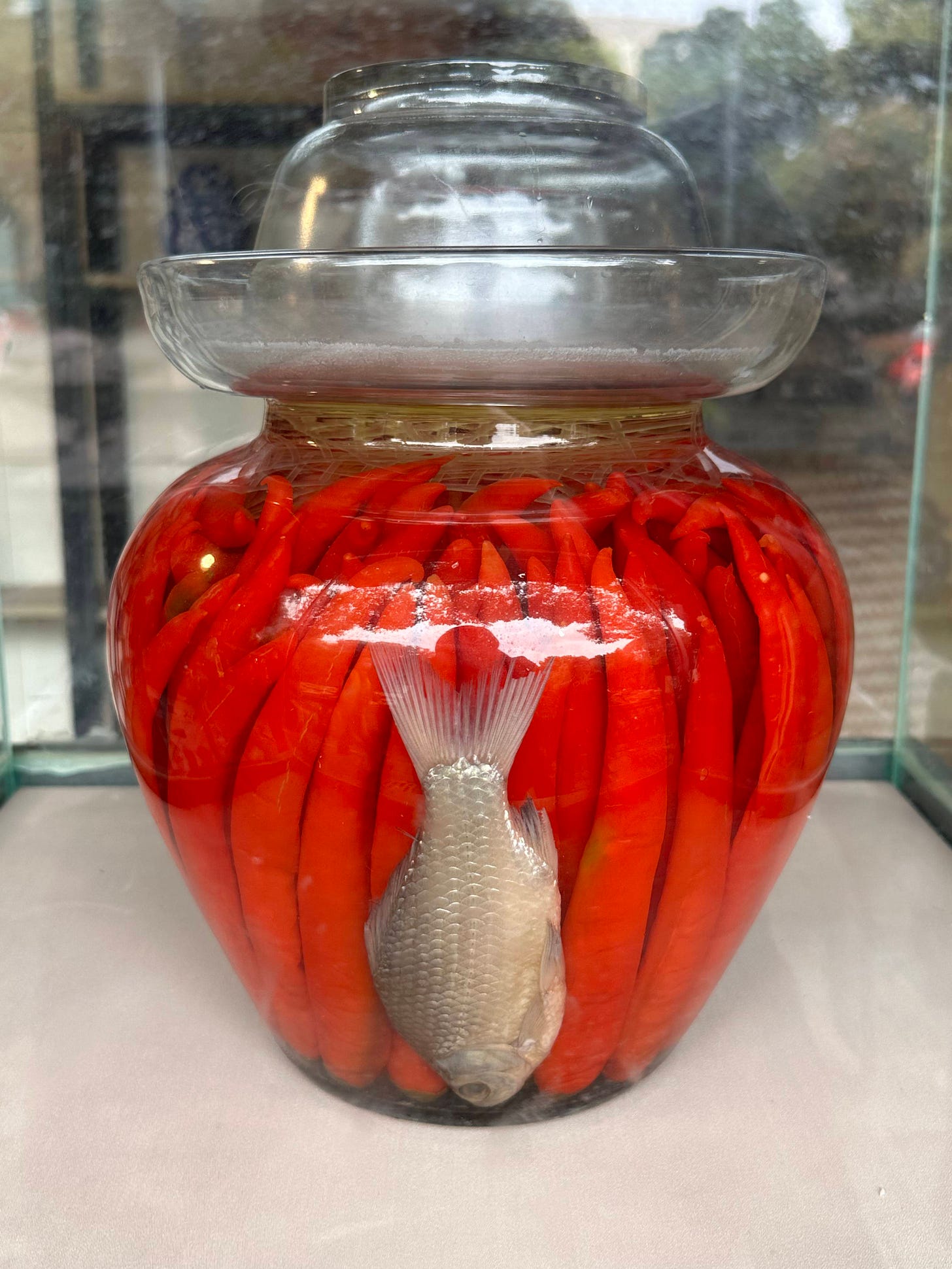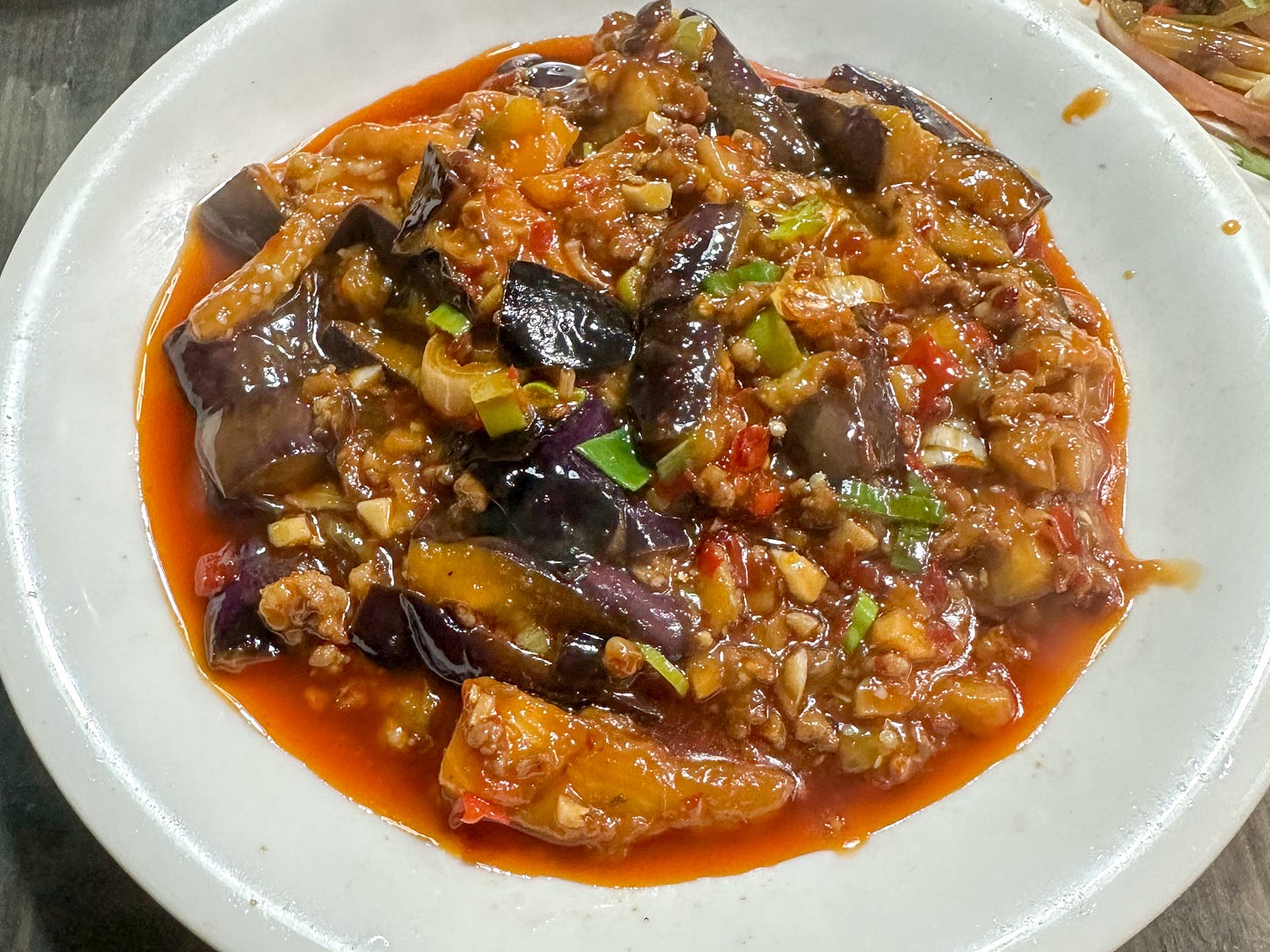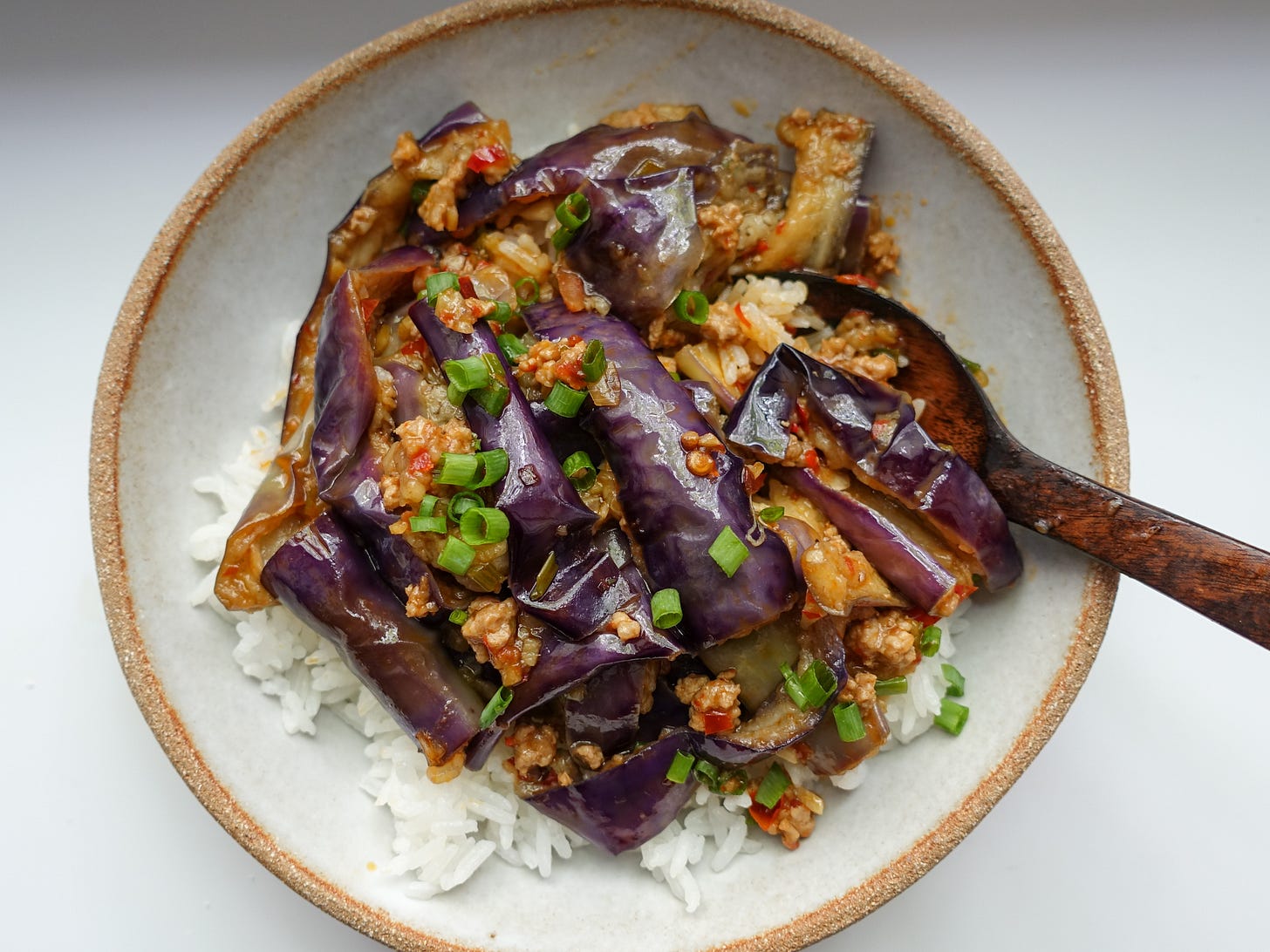Hi! We’re continuing to explore more about cooking with black vinegar. This week, it’s a personal favorite and Sichuan classic: fish-fragrant eggplant.
Last December, two of my college friends visited me in Chengdu, and we took a nostalgic stroll through the neighborhood near Sichuan University, where we studied a decade ago. Our lunch spot was Lao Liao Jia, a modest eatery nestled on the ground floor of a residential building. It’s situated on a bizarre, everything-everywhere street called Embassy Street, where foreign embassies, underground techno clubs, local eateries, and Tex-Mex restaurants coexist. I used to take German classes here and grabbed a quick lunch with a bowl of Yibin burning noodles or wontons.
As we shivered in the outdoor sitting area and reminisced old anecdotes, a steaming plate of eggplant arrived. We devoured it in an instant. My friends, who now live in Beijing and Guangzhou gasped, “Why does everything taste so good in Chengdu”. I nodded and tried to take notes with my phone and taste buds, to recreate this fish-fragrant eggplant dish in my Berlin home.
What is Yuxiang (fish-fragrant) flavor?
Yuxiang Qiezi (鱼香茄子), a spicy, garlicky braised eggplant dish, is translated as fish-fragrant eggplant. Fish-fragrant is one of the unique flavor profiles in Sichuan cuisine, characterized by a blend of savory, sweet, sour, and spicy notes. The taste is contributed by the black vinegar and pickled red chili, and a heavy usage of ginger, scallion, and garlic. This dish doesn’t contain fish but gets the name as it’s believed to originate from fish dishes in the early 1900s1. Others believe that a type of fish-infused pickled red chilis (Yulazi 鱼辣子) was used in cooking these dishes2.

The fish-fragrant sauce is mostly known in stir-fried pork slivers (Yuxiang Rousi, 鱼香肉丝) and eggplants, but can also be paired with chicken, tofu, and rape shoots. You’d find cold dishes featuring fava beans or peas dressed in this flavorful sauce. Food writer Shi Guanghua asserts that the deep-frying and braising technique used in fish-fragrant eggplants most closely resembles the original fish dish, allowing diners to experience the essence of fish without actually consuming it3.
Recipes I found in the old cookbooks don’t include doubanjiang and pork mince, but the modern-day variations do, especially since pickled chilis are seasonal4. While I lack access to Sichuan-style pickles, typically made from Erjingtiao chilis, I've found that the combination of doubanjiang and pickled piri piri chilis enhances the spicy flavors without overpowering the sauce. Through a few tests, as much as I want to avoid deep-frying, it yields the best texture and flavor, but you can find alternative methods provided below. This dish is perfect to make vegan, too, just omit the pork or use a vegan substitute.
Watch me make it here!
The recipe
Servings: 2
Ingredients
500 g eggplant
100 g pork mince
1 tbsp cornstarch
3 cloves garlic
2 scallions
10 g ginger
3-5 pickled red chilis
1 tsp Doubanjiang
1 tbsp soy sauce
1 tbsp sugar
200 ml vegetable stock
Starch water: 1 tsp starch + 2 tbsp water
Oil for frying
⠀Instructions
Finely mince the garlic and ginger. Thinly slice the scallions, reserving the green parts for garnish. Deseed the pickled chilis and finely mince them. Finely chop the doubanjiang.
Quarter the eggplants lengthwise, then cut them into strips approximately 2cm thick and 5-7cm long. Evenly coat them with cornstarch.
In a wok or deep frying pan, heat enough oil for frying to 170°C/340ºF. Fry the eggplants in batches for about 2 minutes each, until soft. Remove and place them on a paper towel-lined tray to drain excess oil.
In the same wok, adding some oil (you can reuse the frying oil). Heat the remaining oil over medium heat, then add the pork mince. Fry until browned. Add the garlic, ginger, pickled red chilis, and doubanjiang. Stir-fry until fragrant and the mass turns red. Then, add the black vinegar, light soy sauce, and sugar. Mix until well combined.
Deglaze with vegetable stock and bring to a simmer. Add the fried eggplants, carefully mixing them with the sauce. Stir in the starch water and simmer until the sauce thickens to your desired consistency. Adjust seasoning with additional black vinegar if desired, then garnish with sliced scallions. Serve with steamed rice.
Notes on preparation:
Choosing eggplants: I prefer Chinese or Japanese eggplants. If you’re using globe eggplants, peel the skin to create a softer texture.
Alternative to deep-frying the eggplants
Microwaving: Microwave the eggplants on high heat for 5-7 minutes until soft.
Steaming: Steam the eggplants for about 10-15 minutes until tender.
Pan-Frying: Heat about 2 tbsp of oil in a pan over medium-low heat, then fry the eggplants until soft.
Tip: Soaking the eggplants in water with salt or white vinegar can help retain their color. Simply soak for 15 minutes, then drain and pat dry before cooking. This method can be used before microwaving or pan-frying.
Substitutes for pickled red chili: If Sichuan-style pickled red chilis are unavailable, piri piri chili (what I used in video, very spicy) or pickled chili sauce can be used as substitutes. Alternatively, follow Kenji's suggestion and pickle your own Thai chilis in hot vinegar.
Reusing Frying Oil: Frying oil can be filtered and reused for regular cooking purposes.
This origin story is widely accepted and supported by food historian Lan Yong in his book on history of Sichuan Cuisine (“中国川菜史”) and the old cookbook “中国川菜大观” in the 1990s.
Lan Yong argues that fish-pickled red chilis were rarely used in actual cooking.
Quoted from Shi Guanghua’s book “My Sichuan cooking life” (我的川菜生活)
As mentioned in a book on Sichuan cooking techniques (细说川菜), doubanjiang can be used as a substitute for pickled chili, especially given the seasonal availability of pickles, which may not meet the demands of restaurants.







